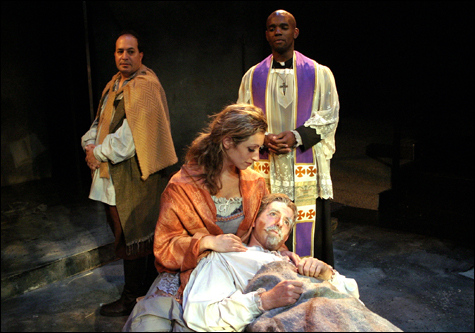
Man of la Mancha |
If it’s “The Impossible Dream” you’ve come for, and you can sit through more than an hour’s worth of the disparate adventures of the once-and-future Knight of the Woeful Countenance before Christopher Chew finally blasts out the anthem, you’ll hit paydirt. But the Lyric Stage Company of Boston revival of the 1965 Broadway juggernaut Man of La Mancha (through October 13) will please mostly the diehards who hold close to their hearts the memory of the sentimental musical about a foolish old man who believes in what might be rather than in what is.
In case you’ve forgotten, book writer Dale Wasserman imagines the classic novel as a play within a play whose curtain rises when its author, Miguel de Cervantes, and his manservant are imprisoned by the dreaded Inquisition for daring to tax a monastery. (Cervantes actually worked for a time as a tax collector.) To keep his fellow inmates at bay and to protect his manuscript from being burned, Cervantes spins out the tale of Don Quixote de la Mancha in dramatic form, asking the prisoners to costume themselves from bits in his trunk and assume all the roles. Cervantes (Chew) himself plays Don Quixote, and his manservant (Robert Saoud) plays Sancho Panza. Man of La Mancha won five 1966 Tony Awards, including Best Composer and Lyricist for Mitch Leigh and Joe Darion, but it turns out that Wasserman wrote the lyrics of “The Impossible Dream.” Perhaps that explains why the words to many of the other songs seem so simplistic, despite the appealing lilt of the Spanish rhythms.

Under the direction of Spiro Veloudos, who’s celebrating his 10th year as artistic director of Lyric Stage, the macho qualities of the story are emphasized by the male chorus of muleteers, particularly in Timothy John Smith’s whip-cracking, testosterone-charged portrayal of Pedro. Caroline deLima, as Aldonza, whom Don Quixote envisions as his Lady Dulcinea, has the acting chops to portray a realistic tavern whore but not the vocal ability to match Chew. She does come through near the end of act two in her bitterly sung-spoken renunciation of Don Quixote’s vision.
Janie E. Howland has designed a huge staircase that drops down into the all-purpose dungeon for entrances and exits, adding to the cramped feel of the staging. Rafael Jaen’s Goya-image-based costume designs work better at making the period spring to life. Ilyse Robbins’s choreography is too abbreviated, particularly for the rape scene that serves as the major dance number, and the pelvis-grinding Gypsy dance is a cliché-driven embarrassment. Musical director and keyboardist Jonathan Goldberg, expert as always, and five more musicians are hidden backstage.
Despite the show’s longevity, the message of Man of La Mancha remains a contradiction: for all that Don Quixote’s illusions of the Don inspire Aldonza and Sancho Panza, he dies, leaving the cynics to inherit his estate. So if you believe that the human race is capable of nobility and kindness, you’re not long for this world — right?